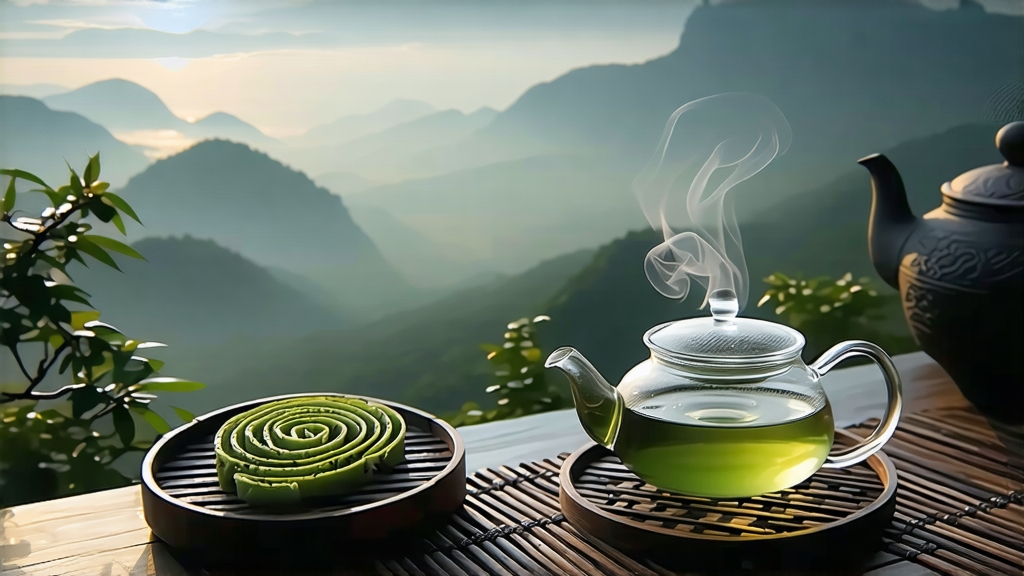
Tucked between the mist-laden slopes of East Dongting Mountain and the vast mirror of Lake Tai, Biluochun—literally “Green Snail Spring”—has captivated Chinese emperors, poets, and modern connoisseurs for over a thousand years. To the international eye it may look like a tangle of tiny green commas, yet each curl contains a full encyclopedia of Chinese horticulture, craftsmanship, and sensory philosophy. This article invites you to travel from Tang-dynasty tribute lists to twenty-first-century sustainability labs, learning how a single cultivar can embody both the delicacy of a spring breeze and the precision of a watchmaker.
-
Historical echoes
The first written record appears in the Tang Dynasty’s “Tea Canon” of Lu Yu (760 CE), which mentions “remarkably fragrant tea from the Dongting region.” By the late Ming dynasty, local monks had nicknamed it “Scary Fragrance” (Xia Sha Ren Xiang) because its intense apricot-and-peony aroma startled visitors during meditation. The Kangxi Emperor, touring the Jiangnan region in 1699, sampled the tea, found the name inelegant, and rechristened it Biluochun for its snail-shell shape and spring harvest. From that moment it entered the gongcha (tribute) roster, transported on fast horses to the Forbidden City alongside pearls and silk. -
Terroir and cultivars
East Dongting Mountain is actually an island peak rising from Lake Tai; 200 foggy days per year slow photosynthesis, concentrating amino acids and fragrant compounds. The soil is a friable granite-loam mix with a pH of 4.5–5.5, perfect for the small-leaf Camellia sinensis var. sinensis. Two clonal selections dominate today:
• Dongting Small-Leaf #1—high in linalool and geraniol, giving lily-like notes.
• Wuxi #5—rich in cis-3-hexenyl acetate, responsible for the signature green-beans-and-wild strawberry finish.
Both are grafted onto 300-year-old mother trees that still stand near the Ming-yue monastery, their gnarled trunks wrapped in moss like living antiques. -
Harvest calendar
The picking window is brutally short: from Grain Rain (April 20) to立夏 (May 5). Only the “flag-bud” set—one unfurled leaf cradling a downy bud—is plucked before 9 a.m., when dew weight keeps cells turgid and prevents oxidation en route to the village. A master picker can gather 600 grams of fresh leaf in four hours; that will shrink to 100 grams after firing, enough for perhaps twenty cups. -
Crafting the spiral
Biluochun is the only famous Chinese green tea whose kill-green, shaping, and drying occur in one uninterrupted 45-minute choreography performed on a 160 °C bamboo-lined wok.
Step 1: Toushi (throw-in) – 0’–3’: 250 g of leaves are tossed like salad to destroy leaf-surface enzymes.
Step 2: Guo (rolling) – 3’–15’: pressure increases from 0.5 kg to 2 kg per hand, forcing cell sap to the surface while the wrist describes a clockwise spiral, imprinting the iconic coil.
Step 3: Cuotuan (rub-cluster) – 15’–25’: palms form a loose cage, rotating the tea against the wok wall; temperature drops to 100 °C so sugars caramelize gently.
Step 4: Tihao (raise hairs) – 25’–35’: fingertips flick the tea upward, breaking fine hairs and releasing white tips that give the dried leaf its silvery sheen.
Step 5: Ganhuo (dry-firing) – 35’–45’: heat ramps back to 130 °C, reducing moisture to 5 %. The master listens for the “sound of pearls,” a rattling that signals readiness.
Throughout, the aroma swings from cut grass to steamed edamame to ripe peach, a sensory metronome against which timing is judged as much as by clock. -
Grading labyrinth
After cooling, tea is sifted into six grades: Supreme, Special #1, Special #2, #1, #2, and #3. Supreme grade demands 70 % bud-to-leaf ratio, spirals no longer than 1.2